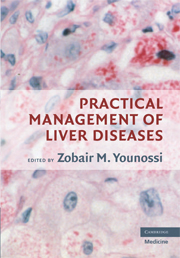Book contents
- Frontmatter
- Contents
- Preface
- Contributors
- 1 Acute Viral Hepatitis
- 2 Chronic Hepatitis B and D
- 3 Chronic Hepatitis C
- 4 HIV and Viral Hepatitis
- 5 Nonalcoholic Fatty Liver Disease
- 6 Alcoholic Liver Disease
- 7 Genetic Hemochromatosis and Iron Overload
- 8 Wilson's Disease
- 9 Alpha-1 Antitrypsin Deficiency and the Liver
- 10 Autoimmune Liver Disease
- 11 Drug-Induced Liver Disease (DILI)
- 12 Benign and Malignant Tumors of the Liver
- 13 Complications of Cirrhosis
- 14 Liver Transplantation
- 15 Novel Technologies in Studying Chronic Liver Disease
- Index
- References
13 - Complications of Cirrhosis
Published online by Cambridge University Press: 08 August 2009
- Frontmatter
- Contents
- Preface
- Contributors
- 1 Acute Viral Hepatitis
- 2 Chronic Hepatitis B and D
- 3 Chronic Hepatitis C
- 4 HIV and Viral Hepatitis
- 5 Nonalcoholic Fatty Liver Disease
- 6 Alcoholic Liver Disease
- 7 Genetic Hemochromatosis and Iron Overload
- 8 Wilson's Disease
- 9 Alpha-1 Antitrypsin Deficiency and the Liver
- 10 Autoimmune Liver Disease
- 11 Drug-Induced Liver Disease (DILI)
- 12 Benign and Malignant Tumors of the Liver
- 13 Complications of Cirrhosis
- 14 Liver Transplantation
- 15 Novel Technologies in Studying Chronic Liver Disease
- Index
- References
Summary
BACKGROUND
Chronic liver disease is one of the leading causes of death in the United States. As a result of the hepatitis C virus (HCV) epidemic 20–30 years ago, it is expected that by 2020 the proportion of chronic HCV patients with cirrhosis will double from 16% to 32%, and there will be a 180% increase in liver-related deaths. Although only liver transplantation is able to reverse the complications of advanced liver disease, the number of patients awaiting orthotopic liver transplantation has grown to 17,562 as of November 2006. Many patients with cirrhosis are not eligible for liver transplantation or may not receive an organ transplant during their lifetime.
Most patients with chronic liver disease receive their medical care from primary care physicians or gastroenterologists. A clear understanding of the pathophysiology of chronic liver disease, its possible complications, and management are important to deliver state of the art care to patients with chronic liver disease.
PROGNOSIS OF CIRRHOSIS
Most chronic liver diseases generally run a steady course with gradual deterioration over time. The natural history of cirrhosis is characterized by an asymptomatic phase, also known as “compensated cirrhosis,” followed by a rapidly progressive phase marked by the development of complications of portal hypertension and/or liver dysfunction, termed “decompensated cirrhosis.” Transition from a compensated to a decompensated stage occurs at a rate of approximately 5–7% per year. The development of decompensation is an important milestone in the natural history of cirrhosis.
- Type
- Chapter
- Information
- Practical Management of Liver Diseases , pp. 215 - 234Publisher: Cambridge University PressPrint publication year: 2008
References
- 1
- Cited by



